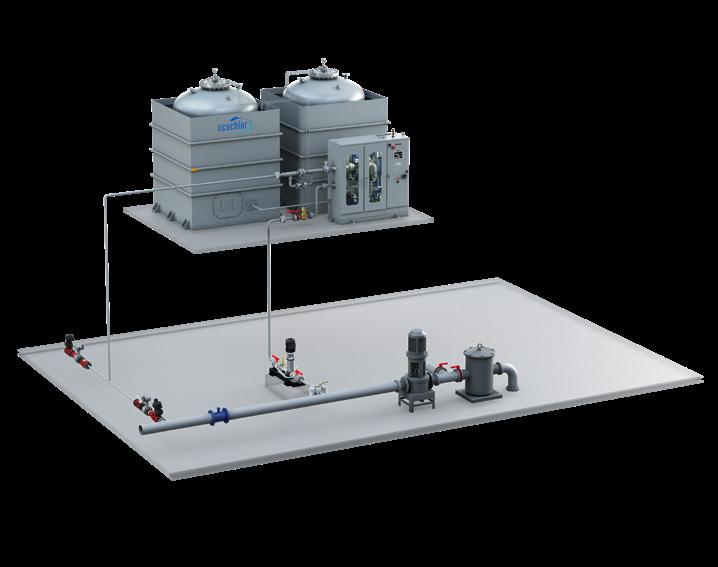
14 minute read
Ballast Water Management
Newport sells first Optimarin system
Newport Shipping has sold the first BWM system from Norway’s Optimarin under their strategic alliance as the pair target an expected rush of retrofits for such systems, with time running out for shipowners ahead of an IMO deadline for compliance.
Advertisement
Around 35,000 vessels still need to install such systems, according to Clarksons Research, with only 40 months remaining until a September 2024 deadline for all ships to comply with IMO’s so-called D2 standard for ballast water discharges.
This alliance enables Newport Shipping to offer shipowners a turnkey package for BWM system retrofits - from project management to installation and compliance testing - as part of a drydocking stay for repair or class renewal work, with available capacity at its 15 partner yards world-wide for fast turnaround.
Newport Shipping also offers deferred payment typically for up to 60% of the total cost of a BWM retrofit over a period of up to 24 months, subject to a credit assessment. In addition, retrofits and other drydocking services can be booked online via its Newport Maritime Services platform. The yard-supplier partnership has now secured the first order for the Optimarin Ballast System (OBS) from a wellknown German shipowner, with other potential orders in the pipeline.
Optimarin has so far delivered around 800 such systems, with another 400 on order, and the flexible modular design of the OBS makes it easy to install and adaptable for a wide range of ship types, with the supplier able to deliver at short notice within only 10 days of the order date.
Its advanced system, with a high level of redundancy, is based on proven technology being constantly developed after more than 20 years of reliable operation and is supported by a global after-sales service network.
Operation and maintenance of the OBS has been significantly enhanced by the recent launch of the OptiLink cloud-based digital solution that facilitates remote troubleshooting 24/7 and data analytics for fleet-wide BWM, which is incorporated in a new service frame agreement.
The Ecochlor BWM system
Ecochlor announces completion of testing
US-based Ecochlor has announced the completion of all land-based and shipboard testing for the filterless, EcoOne BWM system in preparation for an application for USCG and IMO BWM system Code Type Approvals.
DNV was chosen to act as the Independent Lab (IL) throughout the entire process and has been responsible for the evaluation, inspection, testing oversight and submission of the EcoOne BWM system Type Approval applications. The land-based biological efficacy (BE) testing was undertaken by the Golden Bear Research Centre (GBRC) in California, USA. GBRC performed the tests, analysed samples, and managed test results in the format required by the IL. Whole effluent toxicity testing was also performed successfully as part of the landbased trials.
The Shipboard testing, undertaken by DHI as sub-laboratory, was completed to evaluate the BE and related shipboard operational performance (OP) of the EcoOne BWM system on-board a commercial vessel. DHI performed the shipboard tests, analysed samples, managed test results in the format required by the IL. Due to global pandemic restrictions, shipboard testing was allowed to be performed on two commercial vessels owned by Maran Tankers, a VLCC and an Aframax, during their typical vessel voyage routes within the six-month testing period.
The filterless EcoOne BWM system is a onestep treatment process utilising ClO2 alone. Vessels operating this system can operate anywhere in marine and brackish waters (i.e., ≥ 1PSU) and with no restrictions on temperature or turbidity.
The EcoOne Hybrid BWM system has a dual mode of operation with both filtration & ClO2 or ClO2 alone. This system will allow shipowners to operate their BWM system either with or without a filter. This option will be suited for shipowners seeking the flexibility of unrestricted operation in freshwater globally, with the convenience of a no-filter system. Vessels that already have an Ecochlor BWM system with filters installed can upgrade to the Hybrid option with minimal cost.
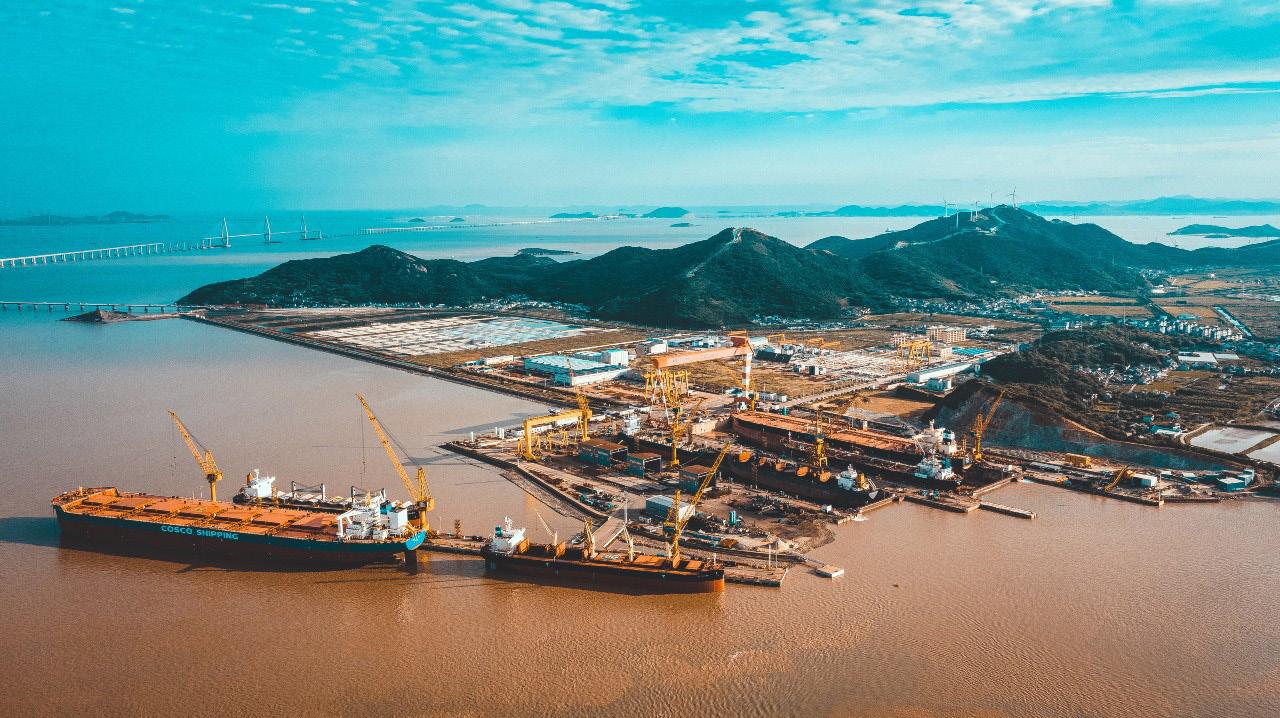
Newport Shipping has access to a wide global network of partner shipyards, including China’s PaxOcean Zhoushan Shipyard
New design from BIO-UV
France’s BIO-UV Group, founded some 21 years ago, has designed a new series of BIOSEA BWM systems compatible with flow rate requirements of up to more than 2,100 m3/hr. The new M-Series BWM system incorporates a novel reactor arrangement designed to increase the flow rate capacity of existing technology without the need for any manifolds.
A range of ‘M’ reactors have been designed for different capacity requirements. These
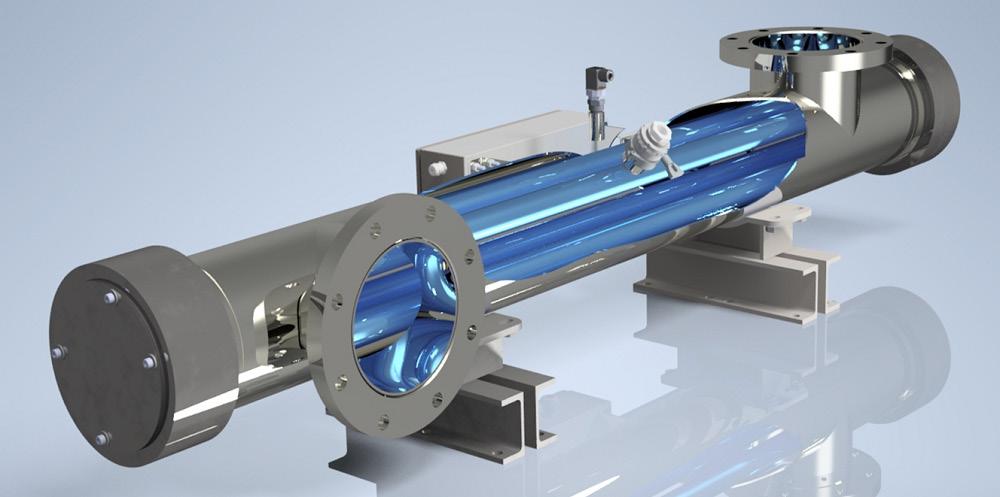
The new BIO-UV M Series reactor
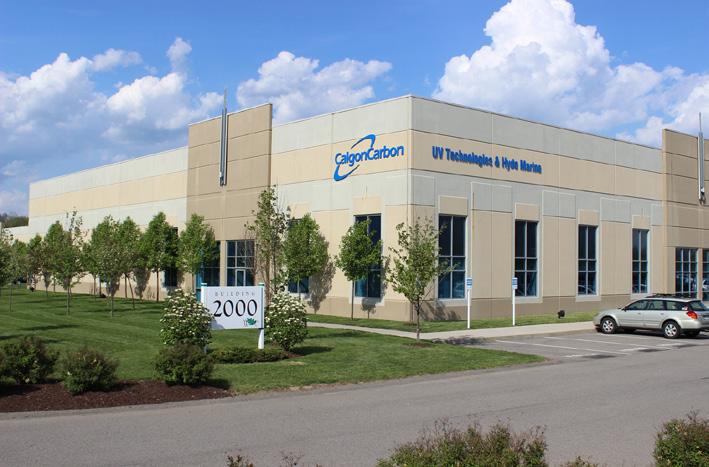
include the M02 for flow rates between 190 and 300 m3/hr, the M04 for 500 to 600 m3/hr flow rates, the M05 (500 to 750 m3/hr), M07 (760 to 1,040 m3/hr), M08 (1,040 to 1,200 m3/hr), M10 (1,040-1,500 m3/hr), and the M14 for 500-2,100 m3/hr flow rates.
In effect, BIO-UV Group has, together with its own integrated engineering department, developed a downscaled version of its existing UV technology to reduce system footprint and integration costs by at least 25%. All environmental testing and UV dosage tests have been done under DNV supervision. IMO and USCG certification documents are imminent.
Available as a modular or skid system and with fewer components resulting in a reduced risk of corrosion, the M-series is available with a short lead time. A number of units are already on the shelf for immediate delivery. BIO-UV Group will continue to manufacture and support the BIO-SEA B-Series, since there are components and spare parts common to both treatment systems.
Some latest orders for the BIO-UV systems have included the CMA CGM 22,000 teu containerships building in South Korea, and the latest large cruiseships building in Italy for MSC Cruises.
De Nora acquires UV Technologies
De Nora has announced that the acquisition of the UV Technologies Division of Calgon Carbon Corporation has been formally completed. The deal covers the products, brands, and assets of UV BWM system world leader Hyde Marine, as well as municipal and industrial water treatment brands RAYOX, SENTINEL and C3 SERIES UV.
The acquisition, first announced last month, creates one of the largest and most experienced BWM system manufacturers in the world. Through the De Nora BALPURE electrolytic disinfection (EC) BWM system and the Hyde Marine ultra-violet (UV) Hyde GUARDIAN system, De Nora is now one of the few suppliers able to offer both UV and EC systems over a full range of flows – providing the perfect solution for any vessel type or route.
This increased range and manufacturing scale provides even more flexibility for
Calgon Carbon Corporation UV Technologies Division facility in Pittsburgh, Pennsylvania
Always first for ballast water treatment www.optimarin.com
First for compliance · First for performance · First for quality
Optimarin leads the way so you can.
We have been dedicated to ballast water treatment for over 25 years, always innovating to set the standard in service, technology and long-term performance.
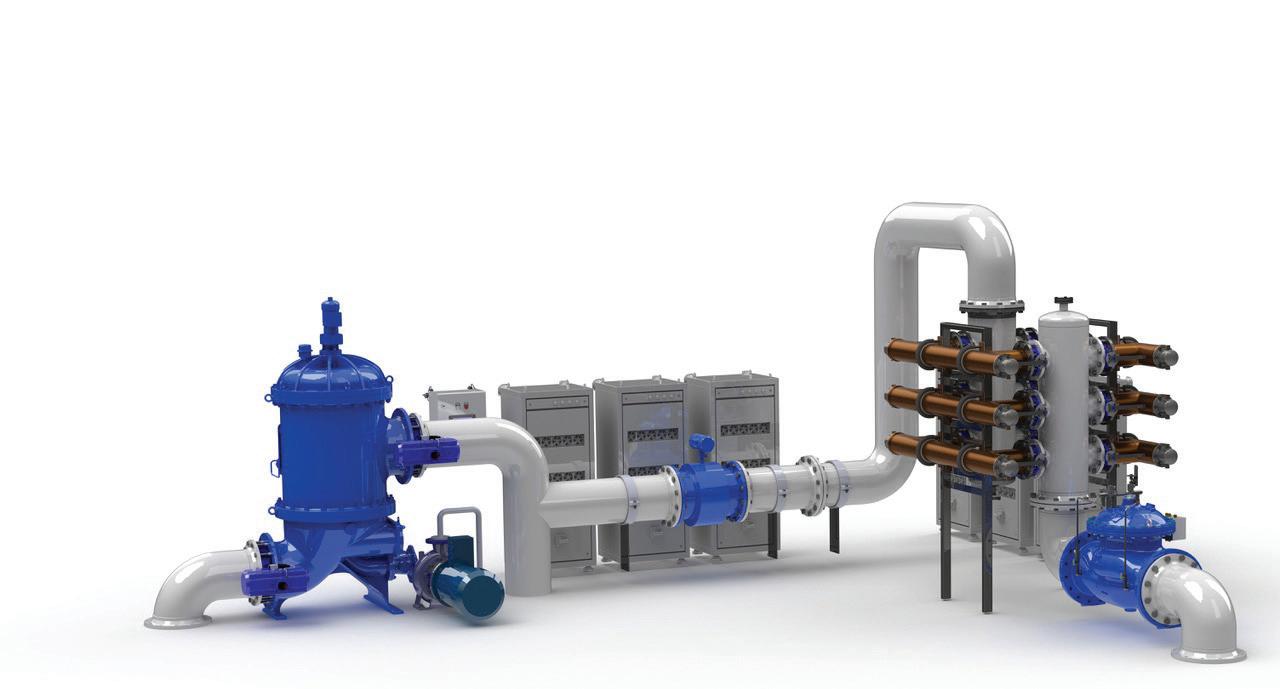
Our proven systems deliver intelligent, flexible and digitally connected operations to ensure you stay one step ahead of regulations – today, tomorrow and far into the future.
shipowners at a critical time, as the industry seeks to comply with IMO’s BWM Convention and the USCG’s regulations.
DESMI wins series contract with MSM
Denmark’s DESMI has signed a frame agreement with Cyprus’ Mastermind Shipmanagement (MSM) to provide 13 DESMI CompactClean BWM systems and engineering services to the modern fleet of Mastermind Shipmanagement. Most of the ships will be retrofitted with the new CompactClean Bulker that is optimised for operation of bulk carriers and other vessel types that can benefit from increased flowrate when discharging ballast water. The bulker solutions also enable optimised performance when the BWM system is operating in IMO waters.
Capt. Eugen-Henning Adami, Founder and Owner of MSM, explains, “We selected DESMI for three good reasons: • Ballast operations always go along with cargo operations. Ports are, however, the bottlenecks in our advanced logistics transport chains. Vessels are, therefore, not allowed to spend time for repairs in ports. With the growing seaborne trade, ports need to turn-around the ships even faster. It is, therefore, imperative that the BWM plant is reliable and works by pressing a button just like the C/O started the ballast pumps in the past. With their decades of experience in manufacturing ballast pumps, DESMI designed a simple and durable system, which is in-house assembled, tested, and verified as a European product. • MSM is very much focused on our carbon food print. We combine the BWM plant with an in-house developed energy/fuel saving technology which offsets the DESMI electricity demand. With this combination, MSM aims to become carbon neutral during ballast operation. • MSM and DESMI joined forces to make the engineering, class approval, installation, crew training, and after sale performance monitoring fast, efficient, and reliable. The large DESMI network is a real asset. Navkratis Ltd, being the local partner in Cyprus, has deep knowledge in marine engineering, which helped MSM in all aspects like a real partner in the jungle of rules/ regulations and technical solutions to find the product that our seafarers deserve to get.”
Navkratis Ltd, being DESMI’s partner in Cyprus, has been central in making this agreement possible by supporting all involved parties locally.
Meanwhile, DESMI has opened an office in Japan, which is a legal entity of DESMI Ocean Guard, and will be headed by Noribumi Suganuma, as of August 1st 2021. He has 18 years’ experience in the shipping and marine industries in Japan, as well as several years’ experience from the automotive industry. He comes from a position as Country Manager for Spectris, HBK Division Japan. With this background Noribumi Suganuma has excellent knowledge about the Japanese shipping industry, and DESMI is convinced that having its own DESMI team in Japan working alongside agents or distributors, when beneficial, will enable the company to get the access to the Japanese market that its products and services merit. Main focus in the beginning will be sale of DESMI’s Marine & Offshore products with special attention to BWM systems.
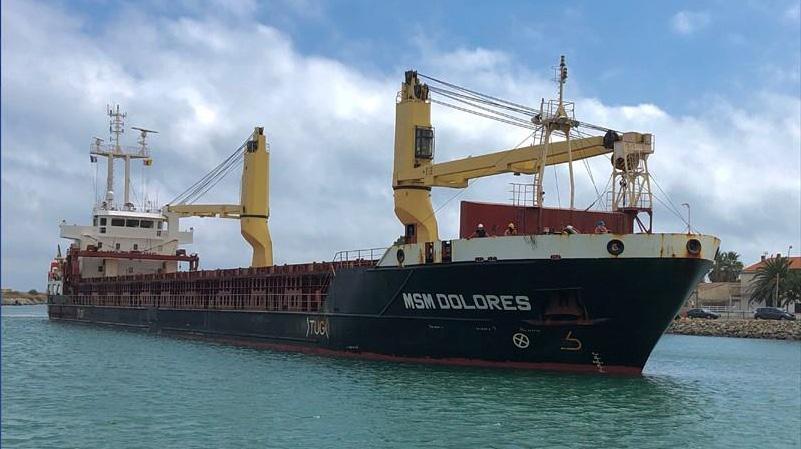
One of the MSM fleet
Techcross looks at APT problems
As a pioneer of the electrolysis technology applying to BWM systems, South Korea’s Techcross has been successful in the market with 3,762 systems installed and delivered of its prominent Electro-Clean System (ECS). Apart from major advantages such as no fine filtration required, small footprint with installation flexibility and competitive price with worldwide AS service network, another big contribution to the success is providing innovative BWM installation solutions for various types of vessels to minimise the CAPEX and OPEX through continuous R&D. One of the examples is After Peak Tank (APT) treatment of tankers using the BWM systems installed on main ballast pipelines. As the main BWM system treats ballast uptake for APT, users could save over US$100,000 by not installing the separate system for APT. Another example is the engine room solution for tankers with submerged pumps (such as MR tankers) and by installing non ex-proof model in the engine room instead of ex-proof model in a hazardous area, users saved 20% of the system price as well as 30% of installation costs. These two solutions eliminate the needs for separate systems for APT and as a result, Techcross provides systems for APT free of charge.
DNV has investigated and approved the only one BWM system for tankers with APT used for ballast water in November 2018. In case only one system full flow electrolysis system is to be installed in a hazardous area it can normally only serve ballast water in the cargo area.
Water taken on-board to safety area (e.g., APT) is not allowed to pass the treatment unit located in hazardous area before entering safe area. However, DNV has evaluated the following sequence as an equivalent solution: • Uptake of untreated water to APT in location A. (All cargo BW tanks must have treated water) • Transport to location B • Transfer of BW in APT over deck through non-return connections to the treatment system in hazardous area and further to an empty BW tank in cargo area • Hold the water in cargo area for the required hold time (according to TA certificate) • Discharge BW using neutralisation as required by type approval.
DNV also stated, “If the treatment system
includes a filter, the backflush water contains living organisms which is not allowed to be discharged in a different location from its origins. When applying treatment, the backflush water is not allowed to be discharged overboard. This water must be collected in a separate tank and later delivered to an onshore treatment facility. Filtering the water during uptake to APT using a separate filter in safe area is not considered equivalent to the process type approved, since the organisms not separated by the filter will grow in size and number before second treatment is applied.
“However, having a separate filter will probably help to reduce particles and organisms allowing less backflush events and less water to collect during transfer of water from APT to cargo area for treatment by the second filter and electrolysis in the cargo area.” This makes full flow systems, with filter, unfeasible for the APT treatment solution.
Techcross ECS without filter can treat APT untreated seawater through the system in hazardous area and further to an empty BW tank in cargo area and then discharge after minimum holding time of 4 hrs. (Not applicable on USCG TA). The system, with minimum holding time of longer than 24 hrs, may delay and intervene in the operation of vessel in port or during drydocking.
In case of tankers with submerged pumps, an explosion proof type full flow system is generally installed in a specially designed room on the deck which involves safety concerns and high cost of installation.
Techcross’ patented installation solution makes it possible to install non-explosion proof type system in the engine room by utilising existing fire/GS pump(s) or adding ballast pump(s) for ballasting operation while using the submerged pumps for de-ballasting operation only. This patented solution provided a great benefit to ship owners/operators in terms of safety and BWM CAPEX and installation costs. This solution has been applied to 50+ newbuild MR tankers at South Korean shipyards as well as retrofits.
EPA’s proposed Vessel Incidental Discharge National Standards of Performance would apply to non-recreational, non-Armed Forces vessels that are 79 ft (24 m) in length and above. For ballast water, the proposed regulations would also apply to small vessels (less than 79 ft in length) and fishing vessels of all sizes. Small vessels transit voyage will also require BWM systems and the smallest unit ECS-150 with compact skid mounted ‘one fits all’ system would be suitable for the needs. Techcross is currently working on R&D for minimising footprint and cost targeting lowest system price and will continue to provide innovative installation solution to all stakeholders through worldwide sales and service networks.
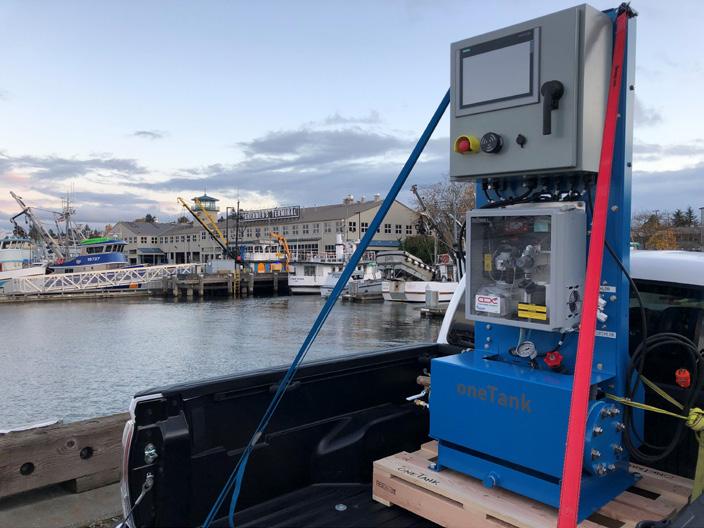
New small system from Erma First
Greece’s Erma First is bringing the world’s smallest and easiest to install BWM system to the international market through its acquisition of US firm oneTANK LLC. oneTANK, a subsidiary of naval architecture and marine engineering firm Glosten, has developed a small scale innovative, low-cost, IMO Revised G8 Code and USCG compliant system.
Based on a patented mixing technology developed by the US Geological Survey (USGS), the system can be installed in larger vessels’ aftpeak tanks. It is also suitable for use on-board workboats, tugboats, semisubmersibles, fishing vessels and superyachts. The technology is already being adopted on ships in aftpeak tanks within Overseas Shipholding Group’s tanker fleet and on the dredger Charlock in the Netherlands.
Erma First has seen significant success with its electro-chlorination systems for larger vessels and is now expanding its portfolio to provide a wider variety of on-board solutions to a larger market than ever before. The move follows its recent acquisition of German water treatment specialist RWO GmbH in May 2021, METIS Cyberspace Technology in 2019 and positions Erma First as a top tier, global provider of environmental protection systems. oneTANK treats ballast water within the vessel’s ballast tank and has no filters, ultraviolet lamps or electrolytic chlorine generators. Its footprint is only 600 mm x 600 mm, half the size of its nearest competitor. Its power consumption is similar to that of a household washing machine. With low-running costs and fully regulatory compliance, oneTANK provides a BWM solution which works in all water qualities and salinities.
The system uses an 8.25% or 12.5% sodium hypochlorite (bleach) and 30% sodium thiosulfate solution – readily available chemicals that can be purchased from suppliers worldwide. Application is practical for smaller vessels as a 20-litre container of 12.5% bleach will treat approximately 288 m3 of ballast water. For larger vessels, oneTANK can treat tanks as large as 4,000 m3. Seawater is automatically treated by applying and mixing the bulk chemicals in-tank, allowing users to treat on their own schedules, avoiding busy in-port times. SORJ
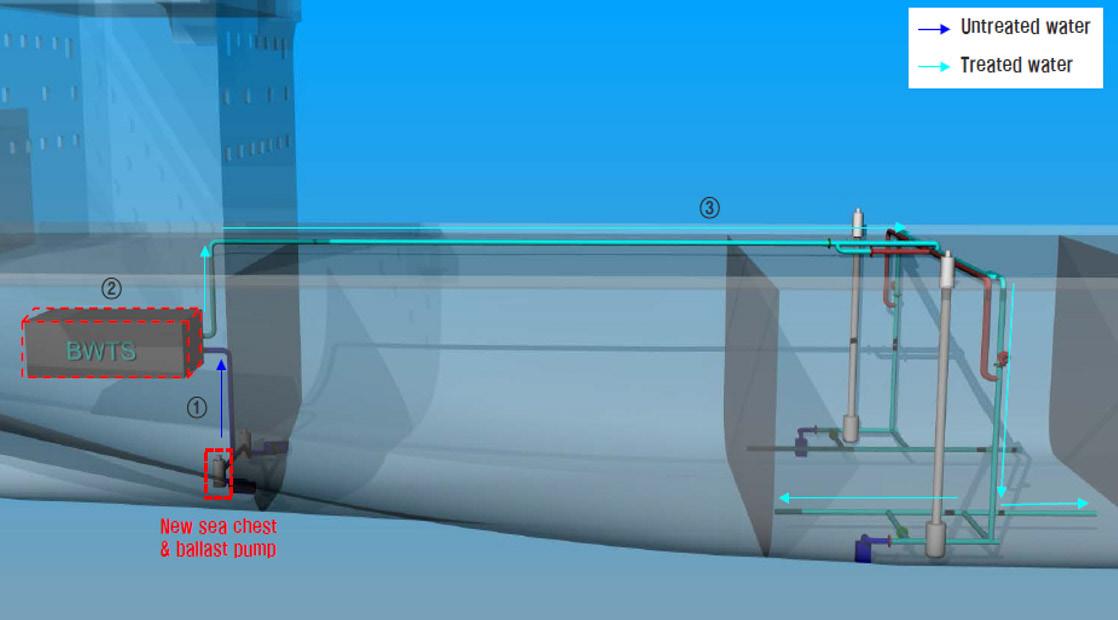
The engine room installation The Erma First system










